 The Cards:
I put the new Visiontek
GeForce3 card through some
comparison testing against GeForce2 Pro and GeForce2 Ultra cards to see
how much better the new card performed. The models I used were the
Visiontek GF2 Pro 32MB DDR card and the Elsa Gladiac GF2 Ultra 64MB DDR
card.
The Cards:
I put the new Visiontek
GeForce3 card through some
comparison testing against GeForce2 Pro and GeForce2 Ultra cards to see
how much better the new card performed. The models I used were the
Visiontek GF2 Pro 32MB DDR card and the Elsa Gladiac GF2 Ultra 64MB DDR
card.
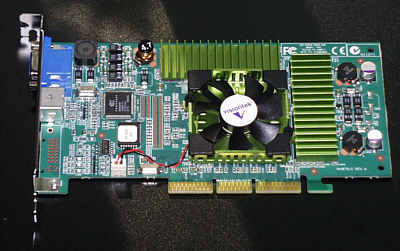
Introduction:
What's different about the GeForce3? Well, it's the first graphics chip
manufactured using 0.15 micron fabrication. That means more
transistors per square millimeter, and cooler operation.
The new features on the GeForce3 include the Vertex
Shader, Pixel Shader, Lightspeed Memory Architecture (crossbar memory controller) and
high resolution antialiasing. The Vertex Shader offers a huge boost to the
capabilities of the hardware T&L of previous GeForce cards. The Vertex
Shader is also programmable, providing for virtually unlimited visual
effects in future games.
The Pixel Shader is an extension of the GeForce2's
Shader Rasterizer, and like the Vertex Shader, it is programmable. This
will add more flexibility to the special effects that can be applied to 3D
scenes.
The new
Crossbow memory controller is made up of 4 64-bit memory sub-controllers working
together. It's an architecture that optimizes memory access. This will help reduce memory latency and improve overall
performance.
Overall, the GeForce3 is a breakthrough in 3D
graphics accelerators, but these cards will not be able to show their
stuff until new games with built-in support come to market. If you are
interested in a detailed description of the GeForce3's new capabilities,
Tom's Hardware has a very thorough article here.
System: I tested the video cards on a 1GHz Athlon system running at 7.5 x 133MHz
(CPU and memory front side bus at 133MHz). I had to make a decision early
on as to what drivers to use. I opted for the older, tried-and-true
Detonator-3 6.50 (WHQL) reference drivers from NVidia for the GF2 cards,
while I used the newer (GF3 optimized?) 12.10 drivers for the GeForce3
card. The system had Windows 98SE and Direct X 8.0a installed.
The default graphics core and DDR memory settings on the
three cards I tested are:
GeForce2 Pro: 200MHz/333MHz
(core - memory)
GeForce2 Ultra: 200MHz/400MHz
GeForce3 card: 200MHz/460MHz
Overclocked settings:
GF2 Pro Overclocked: 200MHz/360MHz
GF3 Overclocked: 200MHz/515MHz
3D Mark 2000 (Direct 3D)
The first test I ran was 3D Mark 2000 version 1.1.
This is a good test of what kind of performance you can expect in today's
crop of Direct 3D games. The results are shown in the next graph.
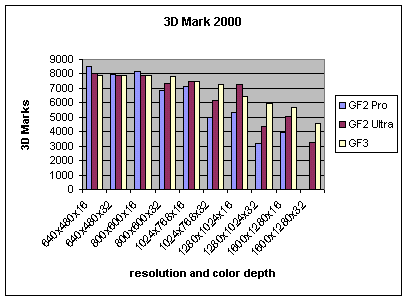
As you can see, the 3 different GeForce cards
performed similarly at low resolutions, but the GF2 Pro card fell behind substantially
at higher resolutions and in 32 bit color. Even the GeForce2 Ultra card
lagged behind significantly at 1600 x 1200 x 32bit. It was apparent that
the GeForce3 card handled 32bit color better than either GF2 card.
3D-Mark 2001 (Direct X 8)
OK, now we get to the benchmark that was designed
for the GeForce 3 card, the new 3D Mark 2001. If the GeForce3 is
going to distinguish itself from it's older siblings, it had better do it
here. The result?

Wham! In 16 bit color, or 32, the GeForce3 card
stomps both GF2 cards into the dirt. And even more impressively, the
GF3 card maintains good frame rates across resolutions and color depths,
with a score well over 3000 3D Marks even at 1600 x 1200 x 32bit.
Performance of the GeForce 3 card was double that of the GeForce2 Pro
card at high resolutions and in 32-bit color. GeForce3 performance was
also notably higher than that of the GeForce2 Ultra. And while there are
no games available yet which can make use of all the special features in
the GeForce3 card, it's good to know that those features will be there
when you need them in the future.
For those of you who have not seen 3D Mark 2001,
it makes most video cards seem obsolete, and there are three benchmark
routines which will not run on most other video cards. What are the
benchmarks that don't run on most other video cards? One is called
"Nature", one is called the "Pixel Shader" and the
last one is "environmental bump mapping". The Nature scene is
particularly beautiful, and extremely complex. It includes trees with
individual branches covered with individual leaves blowing in the breeze, butterflies
flying about, flowing water with multiple special effects, a detailed
cottage next to a bridge, and an old man fishing at the side of the
stream. If they can make games look like that next year, everyone will
want... no, everyone will NEED a GeForce3 card.
Serious Sam (OpenGL)
Serious Sam (Croteam and Gathering of Developers)
is not only a really fun game, it's also an excellent OpenGL benchmark.
And at $19, you just can't beat it!
To benchmark in Serious Sam, open up the console
with the ~ key and type in /dem_bprofile=1 and hit enter. Now play a demo,
and at the end, hit the ~ key again to read the results. You not only get
the average frames per second, and the high and low readings, but also the
number of low sustained frames per second.
To really put some pressure on these video cards I
set all graphics settings to maximum. This can be done easily by
executing the "extreme quality" add-on. I tested at only one
resolution, 1024 x 768 x 32 to keep things manageable. I added one category for the Serious Sam
tests, I overclocked the GeForce2 Pro card from 333 to 350MHz on the DDR
memory to show how much better this card would perform with faster memory.
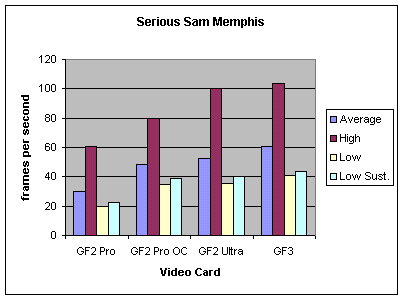
As you can see, Serious Sam is a serious
strain on current systems with the graphics settings at maximum. Clearly
the higher the memory speed, the better results here. Overclocking the
GeForce2 Pro card (2nd set of data) almost doubled the "low
sustained" frame rate. The GeForce3 card outperformed the GeForce2
Ultra in Serious Sam, but not by much.
Quake 3 Team Arena
A quick check with Quake 3 Team Arena showed
little difference between the cards at 1024x768x32 with high detail.
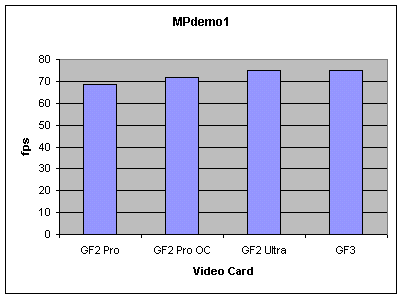
Overclocking the GF3
I used
both Coolbits and Powerstrip 3.0 beta (Entech)
to overclock the memory on the GeForce3 card. Results with both methods
were very similar. The graph below compares 3D Mark 2001 scores with
several memory settings at two resolutions: 1600x1280x32 and
1024x768x32.
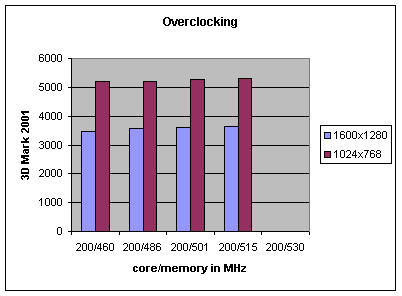
The default memory clock speed is 460MHz. I raised
it in 15MHz increments and tested Direct 3D performance with 3D Mark
2001. The results were not particularly spectacular. Even
though the memory could be overclocked more than 50MHz, the change in
benchmark performance was minimal (3.5% @ 1024x768, 5.5% @
1600x1280). The maximum memory clock setting on the card we tested
was 515MHz. The card failed benchmark tests when overclocked to 530MHz on
the memory.
Finally, I wanted to see what maximum scores I
could get with the GeForce3 card using 3D Mark 2000 and 2001. I used the
default settings for both benchmarks, and made certain that vertical sync
was disabled. I tested the GeForce 3 in a 1.4 GHz Athlon system
(10.5x133MHz) with the video card overclocked to 220MHz/515MHz. I even
enabled fastwrites in the KT7A BIOS. Here are the scores I got with the
default benchmark settings:
3D Mark 2000: 8679 (1024x768x16)
3D Mark 2001: 5477 (1024x768x32)
Compatibility Issues
There were almost no compatibility problems with
the GeForce3 on the several systems I tested. I did notice some
minor menu text problems in Porsche Unleashed, and the sky textures were
missing in Quake3 Team Arena. These are almost certainly driver issues
which will be fixed in the next official NVidia driver release.
Conclusions
The GeForce3 is an impressive piece of hardware,
especially because it is programmable. But in many ways it is like the Pentium 4 processor from
Intel. It is expensive, not much faster in most current games than a
GeForce2 Ultra card, and it requires game developers to write new games
to take advantage of the new features. Until those games come out,
most of the GeForce3 card's impressive features just sit around doing
nothing.
As it stands now, the GeForce3 does not outperform
the GeForce2 Ultra in current games at the screen resolutions most people
use.
When must-have new games that support the
GeForce3 card come out in the next four to eight months, all other video
cards will become obsolete. I expect that the first few high-quality games
that support the pixel shader, vertex shader, environmental bump mapping and point sprites, will become overnight success stories. They will
also help drive GeForce3 sales into the stratosphere.
Based on all we have learned here, this is my
recommendation concerning GeForce3 cards. If you currently own a
GeForce1, GeForce2, GeForce MX or Radeon video card, do not upgrade to a
GeForce3 card yet. Wait until the price drops to around $300. On the
other hand, if you were getting ready to buy a GeForce2 Ultra card, you might want to reconsider. The GeForce3 will have much greater
staying power with future games, and as such, the extra cost will almost
certainly be a good investment. In fact, if you are getting ready to buy any
new video card now, it may be wise to save up your cash until you can
afford a GeForce3 card in a few months. Chances are, everyone will want one when
games support the new features.
Bottom line: unless you are going to watch 3D Mark
2001 all day long, you don't need a GeForce3 card now. The new features
will not be supported in games for at least a few months, and by then, the
price on the cards will be lower. So wait if you can. However, if you must
have a new video card now, the GeForce3 is a must-have item.
Pros:
- Awesome new 3D features
- Complete Direct X 8 support
- Very fast
- Forward-looking (obsolescence
protection)
- Programmable special effects!
- Overclockable
|
Cons:
- Expensive
- No games capable of using effects yet
- Not much faster than a GeForce2
Ultra now
- The wait for games that support GF3
cards may be over 6 months
Price:
Approximately $390 US
Rating, :
4.7 out of 5 smiley faces (94%).
:) :) :) :) +
Availability: Low
|
© Copyright, June 2nd, 2001
|